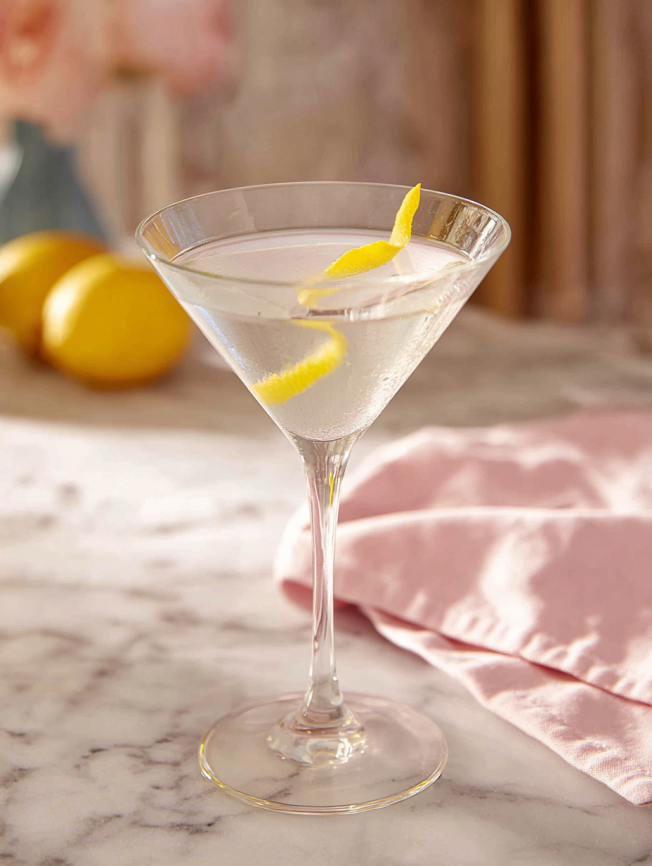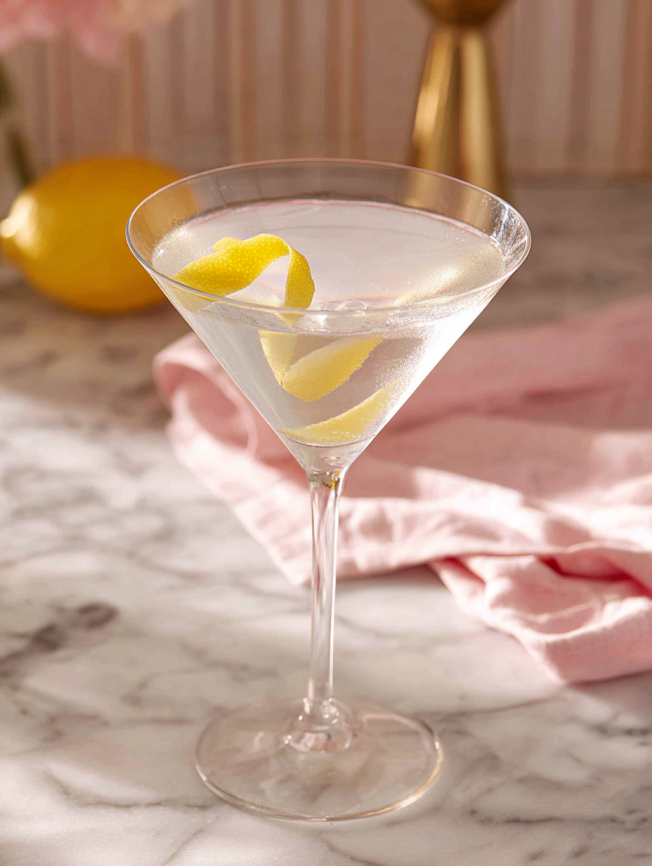There’s something undeniably sophisticated about watching a perfectly crafted martini being stirred in a crystal mixing glass, the ice gently clinking as it chills the spirit to perfection. My love affair with martinis began during a business dinner in Manhattan, where the bartender’s methodical preparation turned cocktail-making into an art form. That evening, I realized that this seemingly simple combination of gin or vodka and vermouth could be so much more than just a drink – it could be a statement of elegance and precision.
Since then, I’ve spent countless evenings perfecting my martini technique, learning that the difference between a good martini and an exceptional one lies entirely in the details. The temperature, the stirring technique, the quality of ingredients, and even the garnish all play crucial roles in creating this legendary cocktail.
Why This Martini Recipe Will Become Your Signature
Timeless Sophistication: Few cocktails command the same respect and admiration as a perfectly executed martini. Moreover, mastering this classic opens the door to understanding fundamental cocktail principles that apply to countless other drinks.
Minimal Ingredients, Maximum Impact: With just two primary ingredients, this cocktail proves that simplicity often yields the most sophisticated results. Additionally, the straightforward recipe makes it accessible to home bartenders of any skill level.
Customization Freedom: The basic martini serves as a canvas for endless variations, allowing you to tailor the drink to your exact preferences. Furthermore, once you master the fundamentals, you can confidently experiment with different ratios and garnishes.
Impressive Entertaining: Nothing elevates a dinner party or special occasion quite like serving properly crafted martinis to your guests. Consequently, this skill becomes an invaluable addition to your hosting repertoire.
Essential Equipment and Ingredients
Required Equipment
- Chilled martini glass – The iconic V-shaped vessel that defines the drinking experience
- Mixing glass – Essential for proper stirring and temperature control
- Cocktail stirrer – For achieving the perfect chill without over-dilution
- Cocktail or fine mesh strainer – Ensures a crystal-clear final product
Core Ingredients
- 2½ ounces vodka or gin – The spirit foundation of your cocktail
- ½ ounce dry vermouth – Provides subtle herbal complexity and balance
- Lemon twist or olives – The finishing touch that completes the experience
Quality Considerations
Choose premium spirits for the best results, as their flavors will be prominently featured in this minimal cocktail. Similarly, fresh vermouth makes a noticeable difference – replace opened bottles every few months for optimal taste. When selecting garnishes, opt for high-quality olives or fresh lemon for the twist.
Step-by-Step Preparation Method
Pre-Preparation
Glass Chilling: Place your martini glass in the freezer approximately 30 minutes before serving. This crucial step ensures your cocktail maintains its ideal temperature from first sip to last.
Mixing Process
Step 1: In your mixing glass, combine the vodka or gin with the dry vermouth. The ratio of spirit to vermouth can be adjusted based on your preference for dryness.
Step 2: Fill the mixing glass with large ice cubes, avoiding crushed ice which melts too quickly and creates unwanted dilution.
Step 3: Stir the mixture consistently for exactly 30 seconds. This timing achieves optimal chilliness while allowing just enough ice melt to balance the alcohol’s intensity.
Final Assembly
Step 4: Using your cocktail strainer, carefully strain the chilled mixture into your frozen martini glass. The liquid should be crystal clear and properly chilled.
Step 5: Add your chosen garnish – either a perfectly twisted lemon peel expressing its oils over the surface, or one to three premium olives skewered on a cocktail pick.

Serving Excellence
Present your martini immediately after preparation to maintain optimal temperature and appearance. The drink should be served neat, without ice in the glass, allowing the full flavor profile to shine through. Hold the glass by its stem to prevent warming the liquid with your hand.
For special occasions, consider rimming the glass with a thin line of salt or serving alongside small appetizers that complement the cocktail’s clean, crisp profile. Classic pairings include oysters, smoked salmon canapés, or aged cheeses.
Creative Martini Variations
Dryness Levels
Extra Dry Martini: Reduce vermouth to just a few drops or rinse the glass with vermouth before discarding the excess. This creates an intensely spirit-forward experience.
50/50 Martini: Use equal parts gin or vodka and vermouth for a more balanced, less alcoholic option that showcases the vermouth’s botanical complexity.
Flavor Variations
Dirty Martini: Add olive brine starting with a splash and increasing up to 1 ounce for pronounced olive flavor. This variation pairs perfectly with stuffed olives as garnish.
Sweet Martini: Replace dry vermouth with sweet vermouth for a completely different flavor profile reminiscent of classic cocktail era preferences.
Citrus-Enhanced: Add a dash of orange bitters to brighten the cocktail with zesty notes. This variation particularly benefits from a lemon twist garnish.
Modern Interpretations
French Martini: Incorporate raspberry liqueur and pineapple juice for a fruity, colorful twist on the classic formula.
Gibson: Simply substitute cocktail onions for olives to create this traditional variation with a sharper, more pungent flavor profile.
Make-Ahead Considerations
While martinis are best served immediately after preparation, you can pre-chill your ingredients and equipment in advance. Store your gin or vodka and vermouth in the freezer, and prepare garnishes earlier in the day.
For entertaining multiple guests, prepare a larger batch by multiplying the recipe proportionally. However, stir each portion individually to maintain proper dilution and temperature control.
Consider pre-chilling multiple glasses when hosting parties, allowing you to serve several perfectly crafted martinis in quick succession.
Professional Tips and Notes
Temperature Control: The secret to exceptional martinis lies in achieving and maintaining the proper temperature throughout the preparation and serving process.
Ice Quality: Use large, dense ice cubes that melt slowly and provide efficient chilling without excessive dilution. Never use crushed ice in martini preparation.
Stirring Technique: Maintain a steady, consistent stirring motion for the full 30 seconds. This ensures even chilling and proper dilution without creating air bubbles.
Vermouth Storage: Keep opened vermouth refrigerated and replace it regularly, as it deteriorates more quickly than base spirits.
Glass Selection: The traditional martini glass shape isn’t just aesthetic – it concentrates aromas while keeping the drink properly chilled.

Frequently Asked Questions
Q: Should I use gin or vodka for my martini? A: This choice comes down to personal preference. Gin provides more botanical complexity and represents the original martini style, while vodka offers a cleaner, more neutral base that some prefer. Try both to discover your preference.
Q: How dry should a martini be? A: Dryness refers to the amount of vermouth used. Start with the standard ½ ounce ratio and adjust according to taste. Some prefer just a rinse of vermouth, while others enjoy a more pronounced vermouth presence.
Q: Why is stirring preferred over shaking? A: Stirring maintains the cocktail’s silky texture and crystal-clear appearance. Shaking introduces air bubbles and can make the drink cloudy, though some bartenders and drinkers do prefer shaken martinis for their slightly different mouthfeel.
Q: How long will a martini stay properly chilled? A: A properly made martini should remain pleasantly cold for about 10-15 minutes in a pre-chilled glass. Beyond that, it will gradually warm and lose its optimal drinking temperature.
Q: Can I prepare martinis in advance for a party? A: While individual cocktails should be prepared fresh, you can pre-mix larger batches and store them in the freezer. Stir well before serving and add fresh garnishes to each glass.
Q: What’s the difference between olives and a lemon twist? A: Olives add a briny, savory element that complements the drink’s clean profile. A lemon twist provides citrus oils that brighten the cocktail’s aroma and add subtle flavor complexity. Both are traditional and equally valid choices.
Q: My vermouth seems to make the drink taste off. What’s wrong? A: Vermouth deteriorates quickly once opened and should be refrigerated. If your vermouth tastes flat or overly sweet, replace it with a fresh bottle. Quality vermouth makes a significant difference in the final cocktail.
Q: How important is the quality of gin or vodka? A: Very important, since these spirits comprise the majority of your cocktail. Premium spirits with clean, smooth profiles will create noticeably better martinis than budget alternatives.
Recipe Summary:
- Total Time: 5 minutes
- Preparation Time: 5 minutes
- Servings: 1 perfectly crafted cocktail
- Course: Drinks
- Cuisine: American classic
Nutritional Information (per serving):
- Calories: 175
- Carbohydrates: 1g
- Protein: 1g
- Sodium: 1mg
- Potassium: 1mg
- Iron: 1mg
